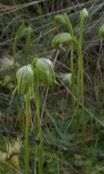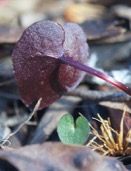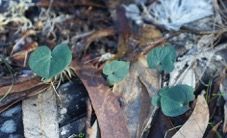Continuing our observations of greenhoods in the district we are still finding good specimens of the Banded Greenhood, Pterostylis sanguinea, featured in our June report.
This greenhood is now joined with perhaps the most common of our orchids, the familiar Nodding Greenhood, P. nutans. A number of flowers have already opened, while literally thousands of rosettes are carpeting the ground throughout the district.

Nodding Greenhoods
The Trim Greenhood, P. concinna, has started flowering. It is, as its name implies, a slender, neat orchid growing to about 15cm tall. It has a distinctive small flower, solitary, white and dark green with brown colouring. The lateral sepals are erect, and the hood curves forward ending in a downward pointing tip. If you look carefully you should see the deeply notched, brownish labellum above the frontal opening of the flower.

Trim Greenhood
Tall Greenhoods, P. melagramma, and the rare Green-striped Greenhood, P. chlorogramma, are in bud, and rosettes of the Blunt Greenhood, P.curta, and the Dwarf Greenhood, P. nana, can also be found.
The orchid of the month award must go to the small Mosquito Orchid, Acaianthus pusillus, which, after the recent rains, is flowering in profusion in scrubland, forest and woodland. The tiny flowers resemble insects with five to twelve of these green to dark brown flowers being borne on a slender greenish-brown stem to a height of 20 cm, though many are much shorter.

Mosquito Orchid
The orchid often forms large colonies with the heart-shaped leaves, green on top, purplish below carpeting the ground.

Undersurface of leaf
The species produces a replacement tuber each season after flowering. Most produce additional tubers, which together with seed from the flowering plants form the colonies that often grow camouflaged in leaf litter.

Leaves among litter
The tiny flowers secrete nectar that attracts pollinating gnats with the pollinia being attached to the insect as it feeds on the nectar.
Other orchids are also appearing in the district. The Small Helmet, Corybas unguiculatus, is flowering, while small leaves with tiny buds of the Veined Helmet Orchid, C. diemenicus, and the Slaty Helmet Orchid, C. incurvus, are pushing their way through the damp soil.
It is certainly a great time to be out exploring the orchid world. Please let us know of your successes. Photos and descriptions of all our orchids are found in Orchids of the Anglesea District available from Angair.
Margaret MacDonald